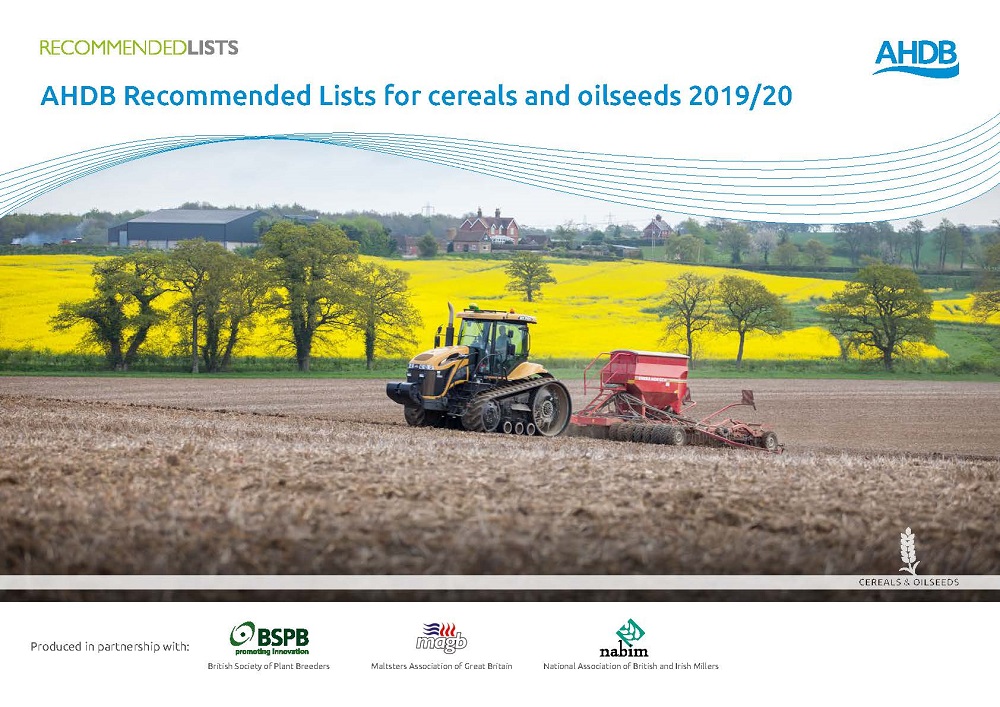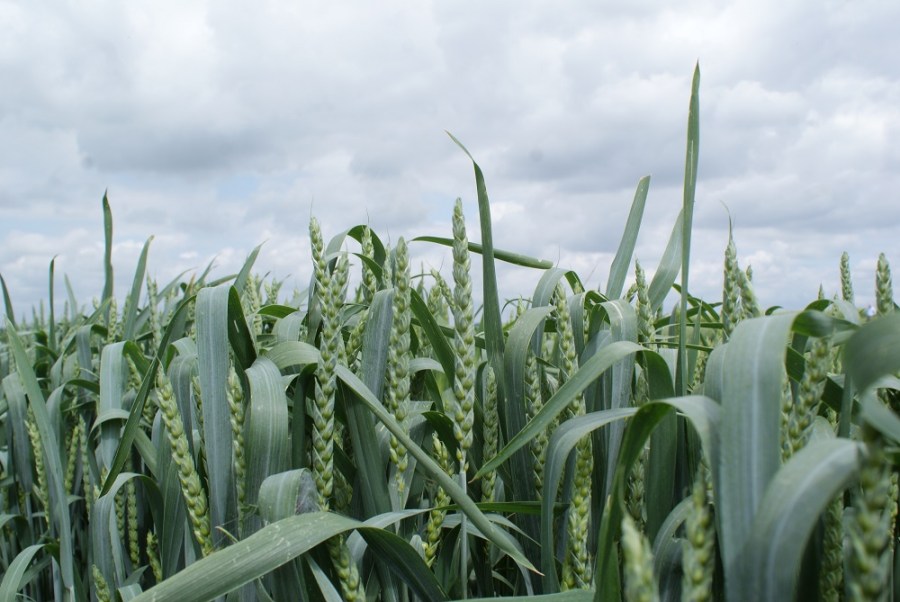With 35 varieties on this year’s AHDB Recommended List, the choice is overwhelming. CPM takes a deep dive into the RL data and finds out about other sources of information that can help guide variety decisions.25 of the 35 wheat
“varieties listed aren’t significantly differently from one another.”
By Lucy de la Pasture
It’s the time of year when cereal crops look at their best and many growers visit trials sites to gain an insight into the many different cereal varieties on offer. Broad and deep green flag leaves and big ears catch the eye, with promises of yield potential and a full grainstore.
Independent agronomist, David Lines, believes a deeper analysis of the data available on the AHDB Recommended List is essential before being seduced by headline yield figures and a harder look at the figures can help avoid any nasty surprises.

With 35 wheat varieties on the 2019-20 RL, there’s plenty to consider when teasing out their suitability.
He believes the best way to assess a variety is by growing a small amount on the farm to see how it performs on your soil type, under the disease pressures and management systems used in practice. But for many of the growers he advises in North Herefords, South Shrops and Worcs, this isn’t always an option, with farm size generally much smaller than their fellow growers in the East.
“The figure that most people tend to look at first on the RL is the fungicide treated yield but when you study these headline figures more closely and apply the statistics, 25 of the 35 wheat varieties listed aren’t significantly differently from one another. In fact only the varieties LG Skyscraper, LG Spotlight, RGT Gravity, Gleam, KWS Kerrin and Shabras have a yield figure that’s significantly different from the control varieties.
“If, more realistically, you compare all the varieties to KWS Zyatt as a benchmark, which has a treated yield figure of 101, then 23 on the list have an equivalent performance,” he says.
“What that means in reality is that for the vast majority, the yield figure shouldn’t be the main reason for selecting a variety as statistically most of them perform at a very similar level. The seed trade will always push new varieties but it’s important to understand that yield isn’t everything,” he explains.
David believes it’s more revealing to look at the untreated yield figures which are given as a percentage of treated control. Even though the LSD for these is 5.3, there are big differences between varieties, with KWS Extase topping the rankings with a score of 95, which is statistically better than any other variety. The next best is Graham (88) which statistically puts it in the same bracket as KWS Zyatt, RGT Illustrious, KWS Siskin, KWS Firefly, LG Skyscraper, Bennington, LG Sundance, LG Motown, Gleam, KWS Crispin and Dunston.
“Even more interesting is to look at the combined treated and untreated figures which helps draw out the differences even more, with KWS Extase having a combined total of 196 compared with RGT Gravity at 184, Leeds at 167 and Myriad at 161,” he comments.
NIAB technical director, Bill Clark, is of the same opinion and he performs a more detailed analysis of the RL which is available to NIAB-TAG members and puts a different perspective on the RL data and provides plenty of food for thought.
One of the factors he considers important is the resilience of a variety, that is how variable it is from site to site and year to year.
“We publish this data for our members so they can pick a variety that is very consistent over sites and seasons. This allows them to make a better judgement of a variety’s performance, rather than just look at the highest treated yield on the list.
“As an example, of the Group 2s – KWS Siskin is the least variable in terms of yield. KWS Extase, despite its very good septoria resistance, happens to be the most variable in terms of yield. Of the Group 4s – Gleam is not the highest yielding but is the most consistent. LG Skyscraper is the highest yielding but is only at number eight in terms of consistency,” explains Bill.
Another important factor he highlights is the response a variety has to fungicide treatment. “Yes, you can look at the treated and untreated yields and work out the difference, then try to compare, but what we do is calculate the ‘responsiveness’ of a variety, see how consistent it is, then match a fungicide strategy to the variety.”
One of David’s concerns is that KWS Extase and candidate variety Theodore, which he says is getting a lot of interest on farm, will be promoted strongly by the seed trade and growers may be tempted not to apply fungicide.
“Leaving a crop unprotected could open Pandora’s box because it’s not as simple as the treated versus untreated yield figures alone suggest,” he says.
Bill describes the disease resistance ratings as a useful guide. “But it’s important to bear in mind that disease ratings don’t always relate to the way a variety responds to fungicide inputs. Sometimes you can’t relate the yield response of a variety to its disease resistance.”
He also points out that there are a huge number of other management factors that influence a variety’s suitability in any given situation
“Varieties also respond differently to other inputs and management such as nitrogen, drilling date, rotational position etc. Some info on this is available on the RL but not the full picture,” he notes.
It’s not meant as a criticism of the RL, which still provides a valuable resource to growers. “The RL system can’t do everything due to cost restrictions, so NIAB tries to fill in the gaps and give additional information to help members make more informed decisions on variety choice and management,” he says.
Agrii head of agronomy, Colin Lloyd also believes it’s a good idea to look well beyond the RL ratings and match variety genetics to management strategies.
“Despite the lowest disease pressure in recent years, our 13-site national and regional trials programme with more than 30 varieties recorded a highly cost-effective average response of 1.7 t/ha to our four-spray fungicide programme in 2018.
“Interestingly though, individual variety responses ranged from 0.5t/ha to 2.14t/ha nationally and from zero to 5.9t/ha in the north. This underlines how important it is to manage varieties for their particular strengths and weaknesses to get the best out of them at the least cost and risk.”
The RL rating data is generated from a majority of trials which are sown in Oct and these receive a very comprehensive fungicide programme. Although it’s a fungicide regime that would make most growers eyes water, David says that when it’s been compared to other systems on farm in the Syngenta’s Growers Challenge, the AHDB RL protocol has consistently come out on top in terms of margin over input costs.
For wheat, the plots receive Cyflamid (cyflufenamid) plus Crafter (chlorothalonil+ tebuconazole) at T0, with the option of adding epoxiconazole if septoria is present and an optional autumn treatment wasn’t applied.
At T1 the protocol is for Adexar (fluxapyroxad+ epoxiconazole) plus Tracker (boscalid+ epoxiconazole) plus CTL plus Talius (proquinazid), with the option of adding Comet (pyraclostrobin) if rust is developing. T2 is more reflective of farm practice with a recommendation of Ascra Xpro (bixafen+ fluopyram+ prothioconazole) plus CTL with the addition of Cyflamid if mildew is established.
So while the RL gives reasonable guidance, Colin believes it needs to be complemented by the most up-to-date intelligence from trial work under regimes that are more typical of commercial agronomy on the one hand and designed to challenge varieties on the other.
One of the additional sources of variety information is produced by Agrii within their Wheat Advisory List, which brings their own variety findings and analyses together with RL data to help guide growers. The latest 2019 issue shows nearly 90% of the 30 main varieties within Agrii trials, have resistance scores one or more points lower than the RL for at least one of the three main diseases. At the same time, over 40% have untreated lodging scores one full point or more below their RL score.
“These differences primarily arise from the fact that our disease ratings are based on the previous season’s scoring rather than multi-year averages. So if a variety has broken down to disease in the past season our figures really highlight this,” he explains.
“Working with ex-NIAB disease authority, Dr Rosemary Bayles, we also take an informed view rather than a simple site average. For instance, in 2015 we marked JB Diego down because it unexpectedly had a lot of yellow rust at just one of our sites. And thank heavens we did because it then rapidly broke down nationally.
“Rogue results may get in the way of a system designed to minimise environmental variation in assessing genetic potential, but we see them as a crucial early warning growers need to be aware of in their crop management,” he comments.
The Agrii Advisory List has a clear management alert for every one of the seven varieties that make up half of the current season’s wheat plantings. Overall, 43% are markedly more susceptible to yellow rust than their RL scores suggest; 71% have a more obvious brown rust susceptibility and 57% are clearly weaker in the stem.
Stand out examples include Skyfall with a yellow rust resistance score of 3.4 (5.4 on the RL), KWS Kerrin with a brown rust score of 4.2 (against 6.8) and RGT Gravity with a untreated lodging score of 4.0 (6.7).
“These are all good varieties providing we manage them right. With Skyfall, it’s a matter of keeping up the azole partner at T0 – even though it continues to have reasonable septoria strength – and being particularly careful with T0 to T1 and T1 to T2 intervals. With KWS Kerrin, it’s vital to use the right SDHI at T2 and RGT Gravity should never be planted too early and needs a robust PGR programme.
“For the future, KWS Extase and KWS Firefly are certainly varieties to watch for those wishing to make the most of genetics in their agronomy. They gave even lower average responses to fungicides than Graham across our trials network last season, have good straw strength and, unusually, are relatively early to mature,” adds Colin.
The early development of KWS Extase has been exceptionally noticeable this spring and David notes that it’s probably not a variety to chose for an early drilling slot.
“It’s a very high biomass variety and its competitiveness in early spring may make it a useful variety to help manage blackgrass as it has big leaves when young, tillers and won’t be inconvenienced by delayed drilling,” he says.
“Other varieties display a distinct preference for drilling slot, with Graham (103) yielding better than RGT Gravity (101) when sown before 15 Sept but the result flip-flops when drilling is late (mid-Nov to end-Jan). In this position Graham slips to 100 compared to RGT Gravity at 104.
“Similarly Grafton, although no longer listed and not a stand-out variety on yield, is well-suited to the early drilling slot so may have been over-looked as a variety according the RL selection criteria,” he comments.
Drilling date is something growers would be well advised to bear in mind when choosing varieties as the effect this has on disease levels is bigger than the small differences in resistance, points out David.
“The game has changed, and we need to use the available genetics to our best advantage to help protect the chemistry we do have and match the best varieties to suit different situations,” he concludes.




